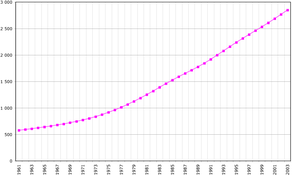- Demographics of Oman
-
This article is about the demographic features of the population of Oman, including population density, ethnicity, education level, health of the populace, economic status, religious affiliations and other aspects of the population.
In Oman, about 50% of the population lives in Muscat and the Batinah coastal plain northwest of the capital; about 200,000 live in the Dhofar (southern) region; and about 30,000 live in the remote Musandam Peninsula on the Strait of Hormuz. Some 600,000 expatriates live in Oman, most of whom are guest workers from India, Pakistan, Bangladesh, Morocco, Jordan, and the Philippines.
Since 1970, the government has given high priority to education in order to develop a domestic work force, which the government considers a vital factor in the country's economic and social progress. In 1986, Oman's first university, Sultan Qaboos University, opened. Other post secondary institutions include a law school, technical college, banking institute, teachers' training college, and health sciences institute. Some 200 scholarships are awarded each year for study abroad.
Nine private colleges exist, providing 2-year post secondary diplomas. Since 1999, the government has embarked on reforms in higher education designed to meet the needs of a growing population, only a small percentage of which are currently admitted to higher education institutions. Under the reformed system, four public regional universities will be created, and incentives are provided by the government to promote the upgrading of the existing nine private colleges and the creation of other degree-granting private colleges.
Overseas Omani people
Today several thousand Omani born people have emigrated abroad, the figures are shown below (only countries with more than 100 Omani born residents are listed).[1]
Country Omani population  United Kingdom
United Kingdom2,024  United States
United States940  Canada
Canada315  Australia
Australia209 CIA World Factbook demographic statistics
The following demographic statistics are from the CIA World Factbook, unless otherwise indicated.[2]
Population
2,694,094 (includes 742,994 non-nationals)
note: Preliminary Results of the Oman Census 2010Age structure
0-14 years: 42.7%(male 744,265/female 714,116)
15-64 years: 54.5% (male 1,079,511/female 783,243)
65 years and over: 2.8% (male 55,180/female 41,770) (2010 est.)Population growth rate
2.023% (2011 est.)
Birth rate
34.79 births/1,000 population (2010 est.)
Death rate
3.65 deaths/1,000 population (2005 est.)
Net migration rate
0.24 migrant(s)/1,000 population (2010 est.)
Sex ratio
at birth: 1.05 male(s)/female
under 15 years: 1.04 male(s)/female
15-64 years: 1.46 male(s)/female
65 years and over: 1.2 male(s)/female
total population: 1.26 male(s)/female (2005 est.)Infant mortality rate
16.88 deaths/1,000 live births (2010 est.)
Life expectancy at birth
total population: 74.16 years
male: 74.87 years
female: 76.55 years (2010 est.)Total fertility rate
2.87 children born/woman (2011 est.)
Urbanisation
About 78% of the population is urban.
Nationality
noun: Omani(s)
adjective: OmaniEthnic groups
Arab, Balushi, Lawati (Khoja), Zadjali (Jadgal), Maimani, Al Saigh, Al Baharinah, Ajami, Jibbali, Afro-Arabian, Persians (Farsi), Filipino, Somali, South Asian (Indian, Pakistani, Sri Lankan, Bangladeshi).
Religions
Ibadhi Muslim 75%, Sunni Muslim, Shi'a Muslim, Hindu
Languages
Arabic (official), English, Swahili, Baluchi, Lawati (Khojki), Zadjali (Jadgali), Gujarati, Ajami, Kamzari, Jibbali (Qarawi): Shehri, Mehri, Habyoti, Bathari, Hikmani, Harsusi, other Indian dialects
Literacy
definition: NA
total population: 75.8%
male: 83.1%
female: 67.2% (2003 est.)References
External links
Government
Ethnic groups in Asia Sovereign
states- Afghanistan
- Armenia
- Azerbaijan
- Bahrain
- Bangladesh
- Bhutan
- Brunei
- Burma (Myanmar)
- Cambodia
- People's Republic of China
- Cyprus
- East Timor (Timor-Leste)
- Egypt
- Georgia
- India
- Indonesia
- Iran
- Iraq
- Israel
- Japan
- Jordan
- Kazakhstan
- North Korea
- South Korea
- Kuwait
- Kyrgyzstan
- Laos
- Lebanon
- Malaysia
- Maldives
- Mongolia
- Nepal
- Oman
- Pakistan
- Philippines
- Qatar
- Russia
- Saudi Arabia
- Singapore
- Sri Lanka
- Syria
- Tajikistan
- Thailand
- Turkey
- Turkmenistan
- United Arab Emirates
- Uzbekistan
- Vietnam
- Yemen
States with limited
recognition- Abkhazia
- Nagorno-Karabakh
- Northern Cyprus
- Palestine
- Republic of China (Taiwan)
- South Ossetia
Dependencies and
other territories- Christmas Island
- Cocos (Keeling) Islands
- Hong Kong
- Macau
Categories:- Omani society
- Demographics by country
- Demographics of the Middle East
Wikimedia Foundation. 2010.

